Bat ecology in the era
of pandemics
Emory students explore
links between wildlife health,
land use and human health
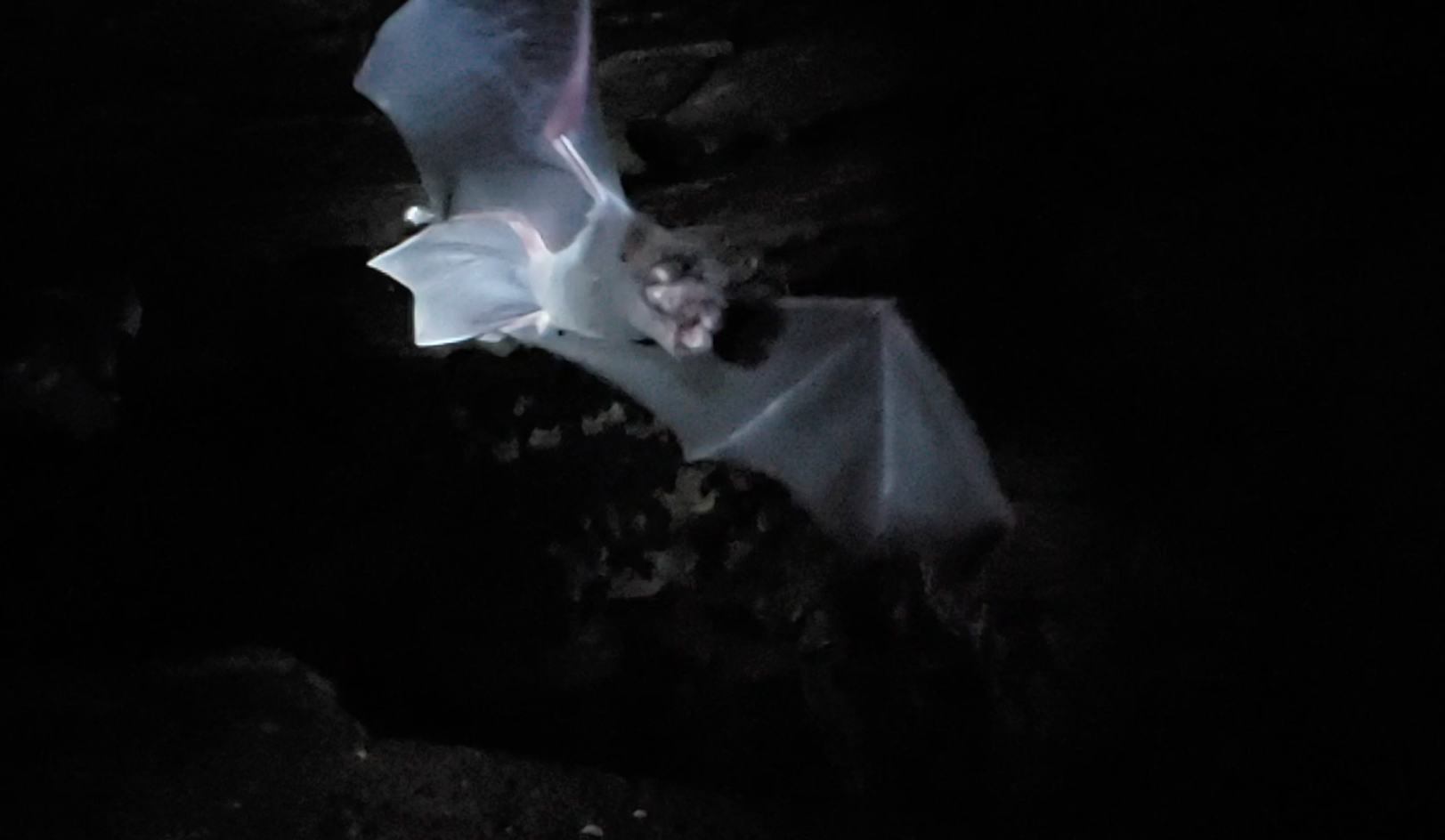
Bats are primarily creatures of the night. Their cape-like wings, alien faces and strange behaviors drive human fascination and fear.
“People have so many misconceptions,” says Amanda Vicente, who studies the disease ecology of bats as an Emory University doctoral candidate. “Bats are associated with dark things, like Dracula. They have never had a good reputation.”
Evidence linking viruses carried by bats to disease outbreaks, from the ongoing COVID-19 pandemic to SARS, Marburg, MERS, Nipah, Hendra and Ebola, is not helping their image.
“It’s important for people to know that our enemies are not the bats, but the pathogens,” Vicente says. “And in order to better fight these pathogens, we need to understand their evolutionary relationship with bats, and how that relationship is being altered by human behaviors.”
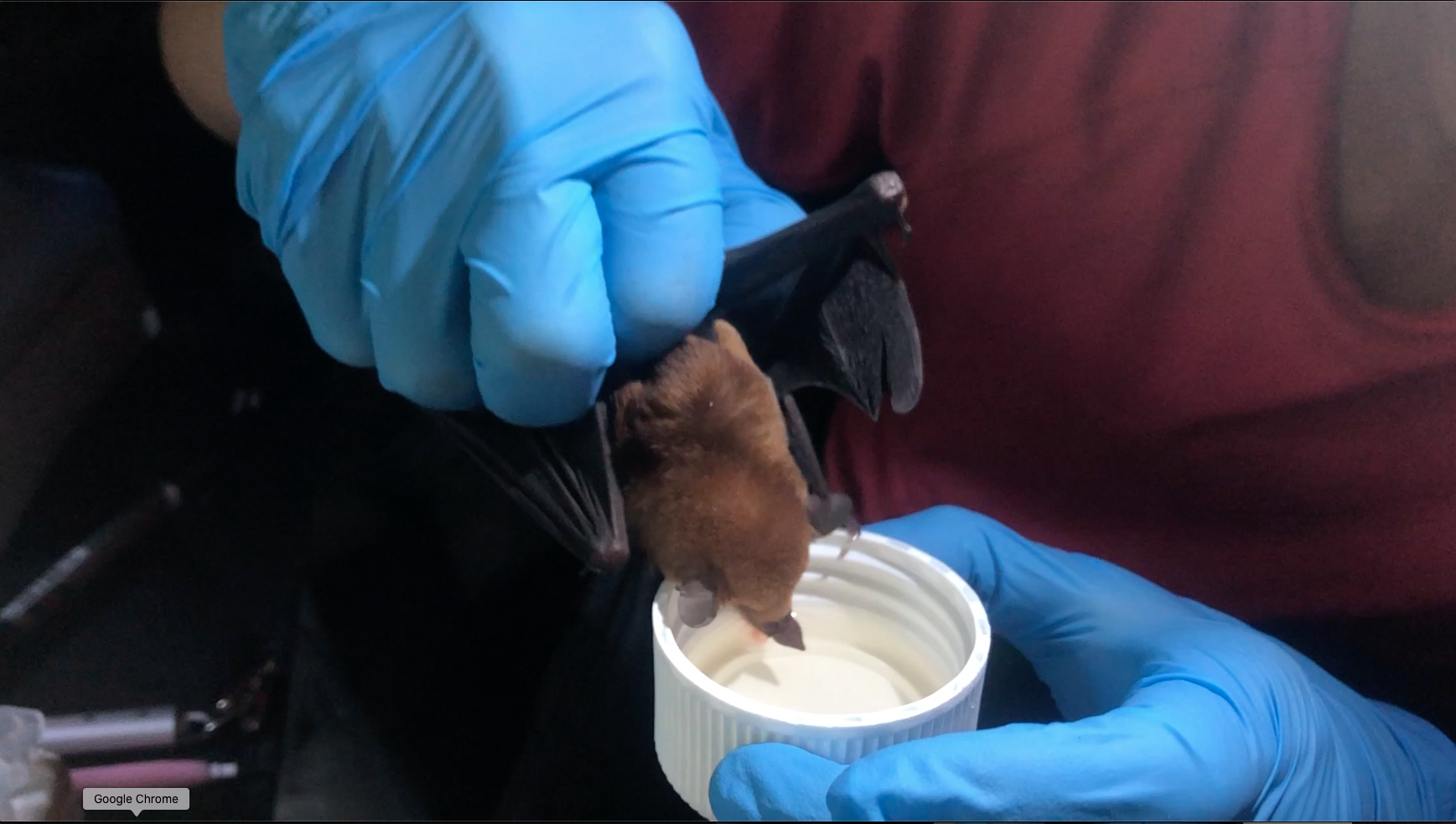
For her dissertation, Vicente is researching cave-dwelling bats of Costa Rica, assisted by fellow students from Emory's Department of Environmental Sciences and Rollins School of Public Health. She has held a fragile, nectar-eating bat the size of a hummingbird. And she has grappled with the three-foot wingspan of a greater spear-nosed bat, marveling at how the bat’s long fingers are actually part of the thin, flexible wings.
“When you hold a bat and really look at it, it’s a life-changing experience,” Vicente says. “They are amazing animals.”
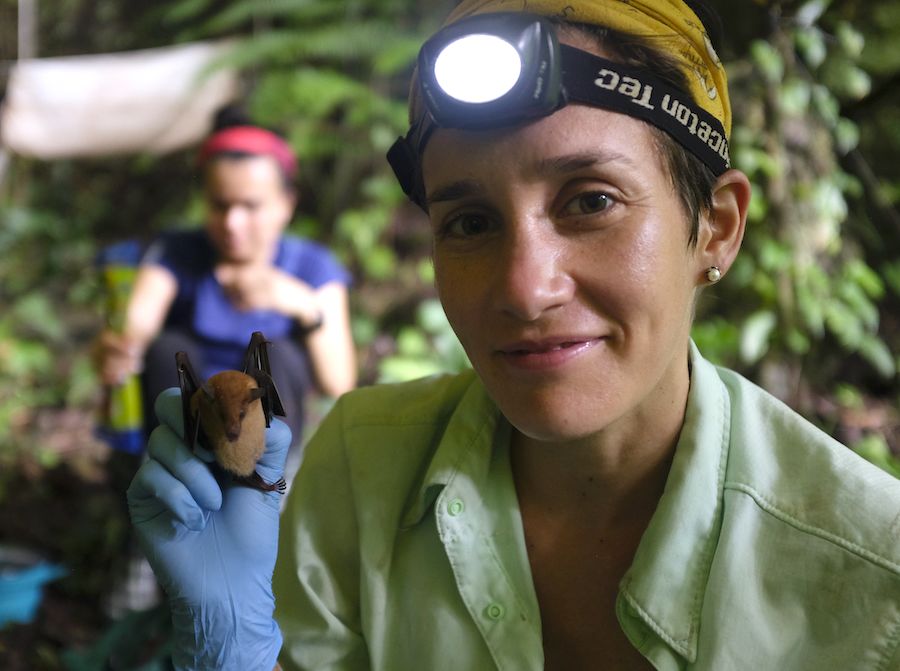
The International Union for Conservation of Nature recently appointed Emory graduate student Amanda Vicente, above, to its Bat Specialist Group — global recognition for her expertise. Her honors include grants from the Explorer’s Club, the American Society of Mammalogists, the American Museum of History, Bat Conservation International and the Cave Research Foundation. (Photo by Neto Villalobos)
The International Union for Conservation of Nature recently appointed Emory graduate student Amanda Vicente, above, to its Bat Specialist Group — global recognition for her expertise. Her honors include grants from the Explorer’s Club, the American Society of Mammalogists, the American Museum of History, Bat Conservation International and the Cave Research Foundation. (Photo by Neto Villalobos)
Bats perform critical functions, she explains, such as pollination and seed dispersion. They eat pests that attack crops, and also mosquitoes and other insects that can spread deadly diseases to humans. They play a vital role in ecosystems on every continent except Antarctica.
And many of those ecosystems are increasingly out of balance.
“Human pressures are having a huge impact on the natural world,” Vicente says. “Our population is rapidly growing. People are cutting down more natural habitats, eating more wildlife, and coming into contact with wild animals more often.”
All these factors boost the risks of a disease jumping from wildlife to people. In fact, most emerging infectious diseases are zoonotic — animal infections that spread to humans.
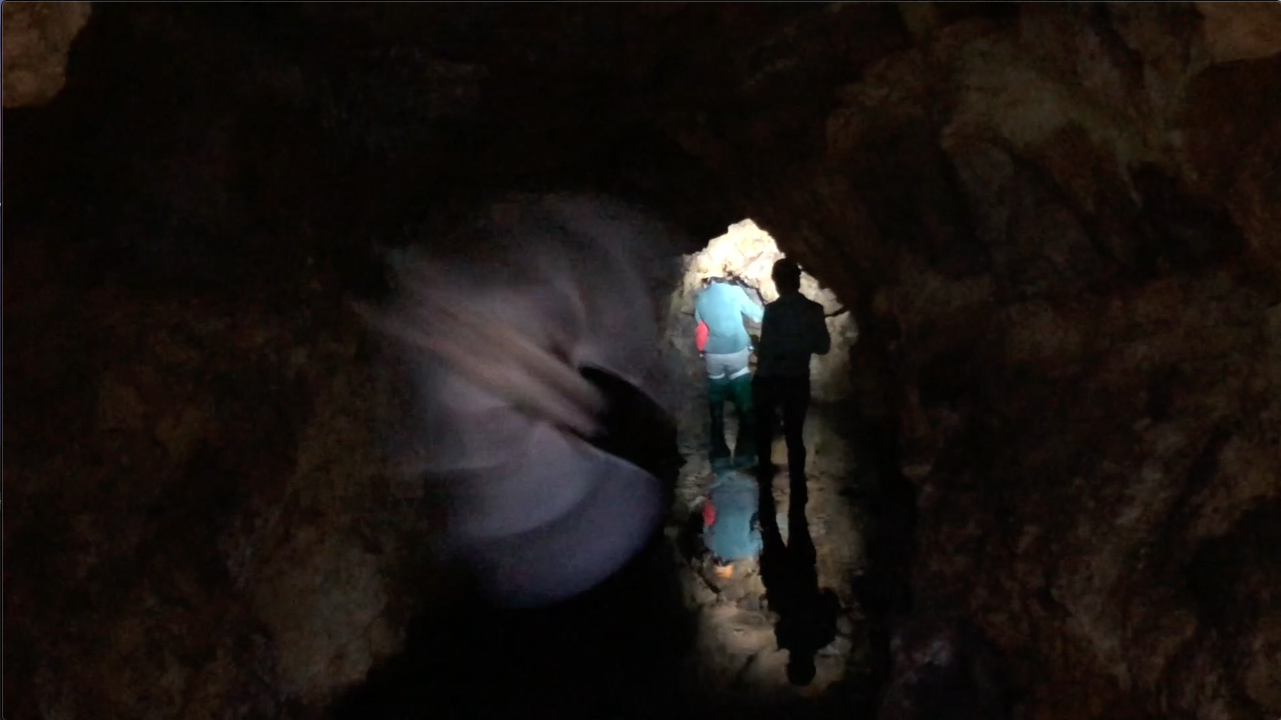
Evidence points to horseshoe bats as the most likely reservoir of the novel coronavirus that causes COVID-19. One theory is that the coronavirus jumped to another species — a scaly mammal called a pangolin — at a live animal market in Wuhan, China, before spilling over into humans.
“The COVID-19 pandemic is just the latest warning shot from nature,” says Thomas Gillespie, associate professor in Emory’s Department of Environmental Sciences and Rollins School of Public Health.
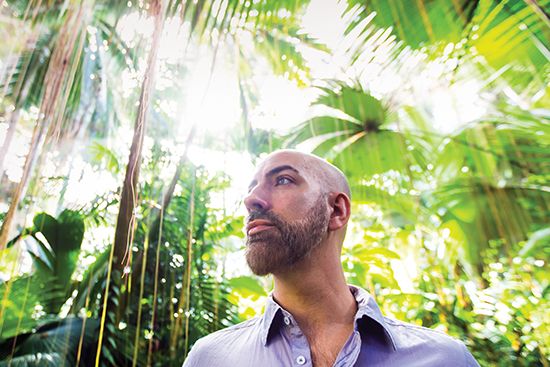
Emory disease ecologist Thomas Gillespie. His lab uses a "One Health" approach, aiming to protect humans, ecosystems and biodiversity by reducing the chances of a pathogen spillover between species.
Emory disease ecologist Thomas Gillespie. His lab uses a "One Health" approach, aiming to protect humans, ecosystems and biodiversity by reducing the chances of a pathogen spillover between species.
Gillespie is Vicente’s PhD advisor. The Gillespie Lab studies how germs jump between wild animals, domesticated animals and people.
The prevalence of bats makes them an important part of the equation. There are more than 1,400 known species of bats, one quarter of mammal species overall. And each bat species carries a suite of different pathogens.
“The typical research into zoonotic disease is far too simplified, but Amanda’s approach is comprehensive,” Gillespie says. “She is passionate about the natural wonder of bats and committed to delving deeply into the nuances of their behaviors. And she’s bridging that knowledge with lab analyses and theoretical modeling.”
Vicente is exploring how human changes to bat habitats — mostly through agriculture and livestock — may stress bats, alter their behaviors and population densities, and change the dynamics for how three different pathogens they carry may spread.
Her research aims at key questions surrounding the “dilution effect,” the theory that biodiversity helps reduce disease transmission.
Ultimately, Vicente hopes to develop a mathematical model that can be applied more universally to help predict — and control — zoonotic disease risks linked to land-use changes.
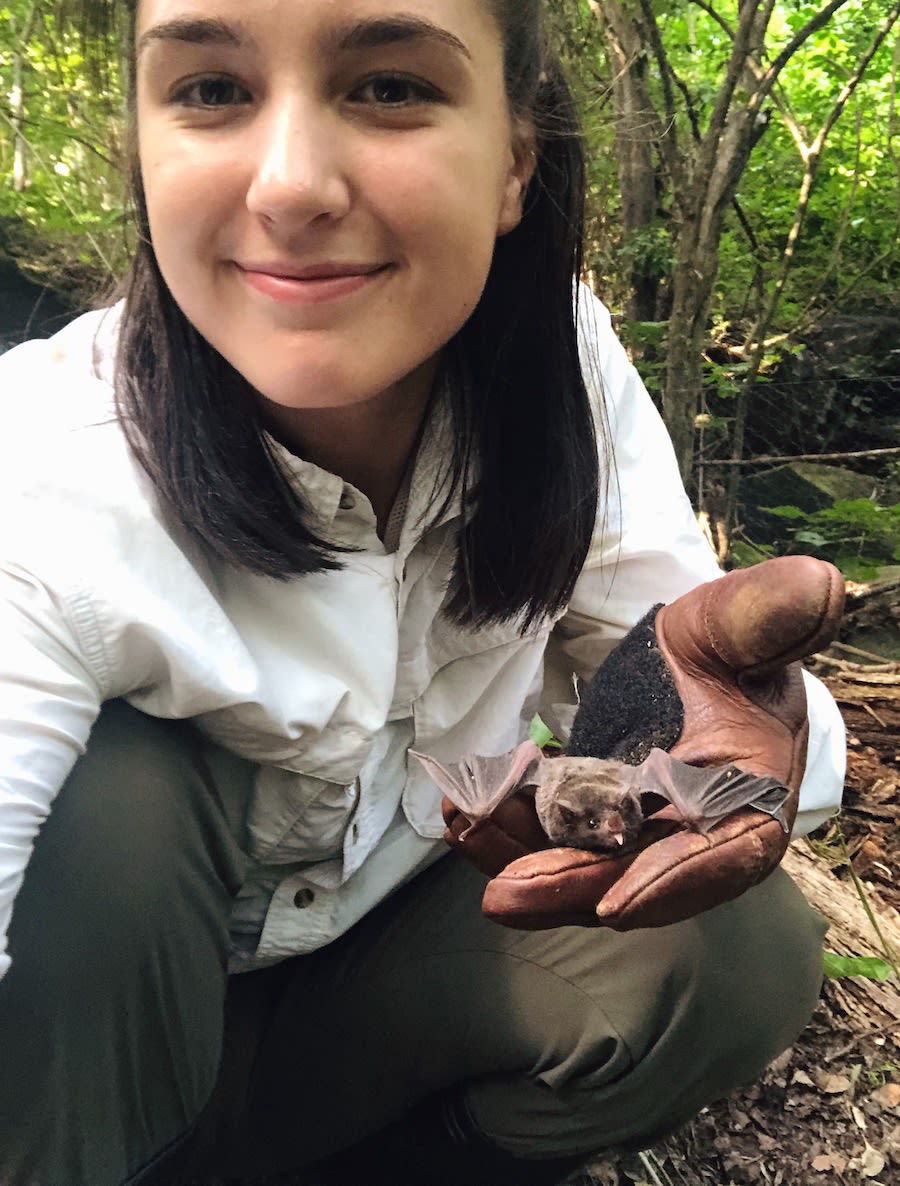
Emory senior Caroline Olson with a Pallas long-tongued bat in the field in Costa Rica last summer.
Emory senior Caroline Olson with a Pallas long-tongued bat in the field in Costa Rica last summer.
“Amanda’s project is extremely important,” says Caroline Olson, an Emory senior who assisted Vicente in the field. Olson is on Emory’s 4+1 BS/MPH program, which means when she receives her bachelors in environmental sciences this May, she will enter an accelerated one-year program for a masters of public health at Rollins School of Public Health.
When Olson helped catch bats for sampling in Costa Rica last summer, she could not have imagined that months later she would be under quarantine in her hometown of Atlanta due to a coronavirus linked to bats in China.
“Bats shouldn’t be blamed for the pandemic,” says Olson, who is considering a career as a physician specialized in infectious diseases. “Instead, they need to be respected and given their space.”

Emory undergraduates Christie Jones, left, and Olivia Milloway in the Gillespie Lab, where they helped analyze blood samples from the Costa Rica bat samples before the lab closed for the semester, due to the pandemic.
Emory undergraduates Christie Jones, left, and Olivia Milloway in the Gillespie Lab, where they helped analyze blood samples from the Costa Rica bat samples before the lab closed for the semester, due to the pandemic.
Christie Jones, an Emory junior who is also in the 4+1 BS/MPH program, agrees. She works in the Gillespie Lab with Vicente, analyzing the bat samples. The Florida native is now quarantined in her apartment in Atlanta where she is fielding questions about bats in texts from family and friends.
“I’m the family bat expert since I’ve been researching them for two years,” she says. “I’m trying to debunk any misguided solutions people suggest, like killing all the bats. Working with Amanda, I’ve learned how wildlife health is connected to human health.”
Vicente grew up in Golfito, a town on Costa Rica's Pacific coast near the border with Panama. Golfito is nestled on a bay within a bay, where humpback whales come to give birth. Tropical fjords — steep mountains covered in rainforest — rise up from the sea. The area is one of the world’s top biodiversity hotspots, home to jaguar, squirrel monkeys, toucans and scarlet macaws.
Her parents ran a boutique hotel and Vicente learned English by playing with children who were visiting from all parts of the world. She spent most of her time outdoors, kayaking in the bay and hiking in the jungle.

A view from the mountains above Golfito, looking down at the bay. (Photo by Neto Villalobos)
A view from the mountains above Golfito, looking down at the bay. (Photo by Neto Villalobos)
“In my childhood imagination, I was an explorer,” she recalls. “I grew up in a place where I was amazed by my surroundings and by all the animals in it.”
Her love of animals led her to major in biology at the University of Costa Rica in San Jose, where she earned a masters in genetics and molecular biology. Vicente worked on population genetics studies of wild mammals in Costa Rica, and how they were affected when humans fragmented their habitats. Howler monkeys, for example, that normally spend most of their time in trees, now must walk on the ground to cross palm oil plantations, where they can get exposed to human diseases. And free-tail bats, that primarily live in caves, have moved into the attics and walls of homes as forests are cut down for urban expansion.

Vicente joined the Gillespie Lab at Emory as a Fulbright Scholar in 2016. She's led small teams in a series of expeditions to survey bats in Costa Rica, including students from Emory and the University of Costa Rica.
Reaching the bat caves required trekking for hours, scrambling over boulders through canyons, crossing rivers in small, indigenous boats, and hiking through dense forest. Vicente, who is barely five-feet tall, and other team members carried all of their necessities on their backs — including scientific equipment, camping gear and food.
Olson, an athlete on the Emory swim team, recalls the physical challenge, as well as the thrill, of ascending 10 kilometers up the side of a volcano. “It was incredible, verdant forest so untouched, and birds everywhere,” she says.
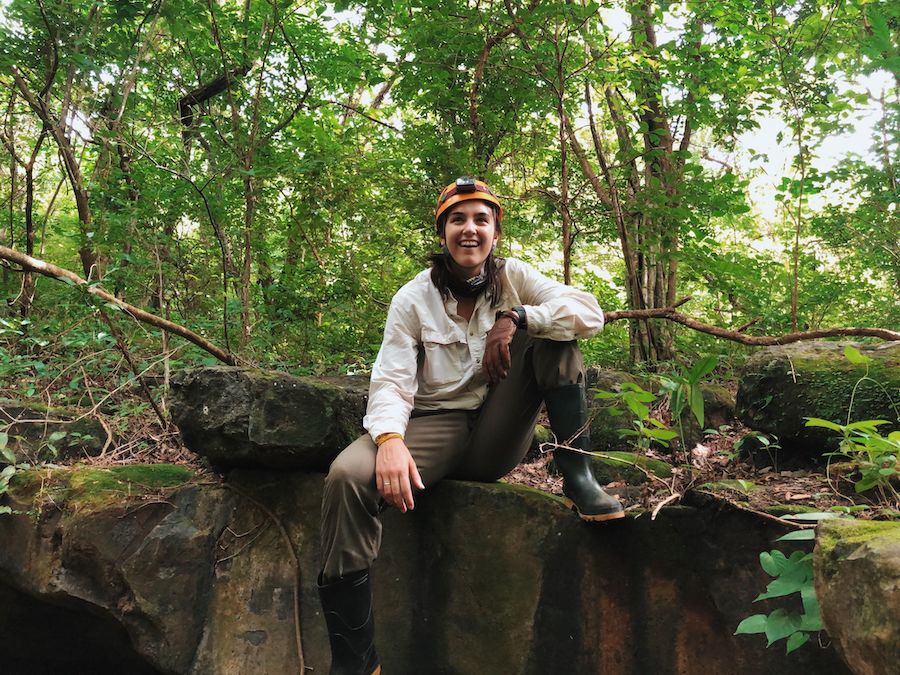
Caroline Olson takes a break atop the entrance to a cave in Costa Rica. (Photo by Amanda Vicente)
Caroline Olson takes a break atop the entrance to a cave in Costa Rica. (Photo by Amanda Vicente)
When it was rainy, they would string their hammocks up in a cave for the night to stay dry. Bats flew in and out around them. They could hear other mammals, like kinkajous and lowland pacas, enter the cave and crack open nuts. Olson loved the lullaby of exotic bird calls and water dripping from leaves. She was mesmerized by what locals call “the devil’s eyes” — jungle fireflies that flash red, instead of yellow.
“A bat would occasionally hit the side of your hammock, but you’d be so exhausted it wouldn’t bother you,” Olson says. And early in the morning, when the bats started returning to the cave in large numbers making high-pitched calls, that was their alarm clock.
Vicente brought in a liquid nitrogen tank to store biological samples so they wouldn’t degrade in the field. The researchers used traps, mist nets, hand nets — even their gloved hands — to catch the animals. Altogether, Vicente's team collected fecal, urine, blood, ectoparasites, tissue and hair samples from 1,325 bats.
Their survey identified nearly two dozen different bat species living in the caves, which reads like a “Who’s Who” of the weird and wonderful. There’s the long-legged bat, known for its habit of gleaning, or hovering just over water and sweeping up insects on the surface using its long hind limbs and big feet. The Pallas’ long-tongued bat has the fastest metabolism ever recorded in a mammal. It hovers like a hummingbird over flowers and extends its bristly tongue — which is nearly half the length of its body — to mop up nectar.
The common vampire bat uses razor-sharp teeth to make a small incision in the ankle of a large mammal, such as a cow or a tapir, so the bat can lap up blood. The hairy-legged vampire bat is known for its strong social bonds: It will regurgitate a blood meal to feed a starving buddy. The pale spear-nosed bat has a repertoire of 20 different vocal calls, similar to that of many non-human primates. And while most bats use echolocation to navigate, Wagner’s mustached bat has been documented using a Doppler shifting technique so it can fly fast through dense foliage.
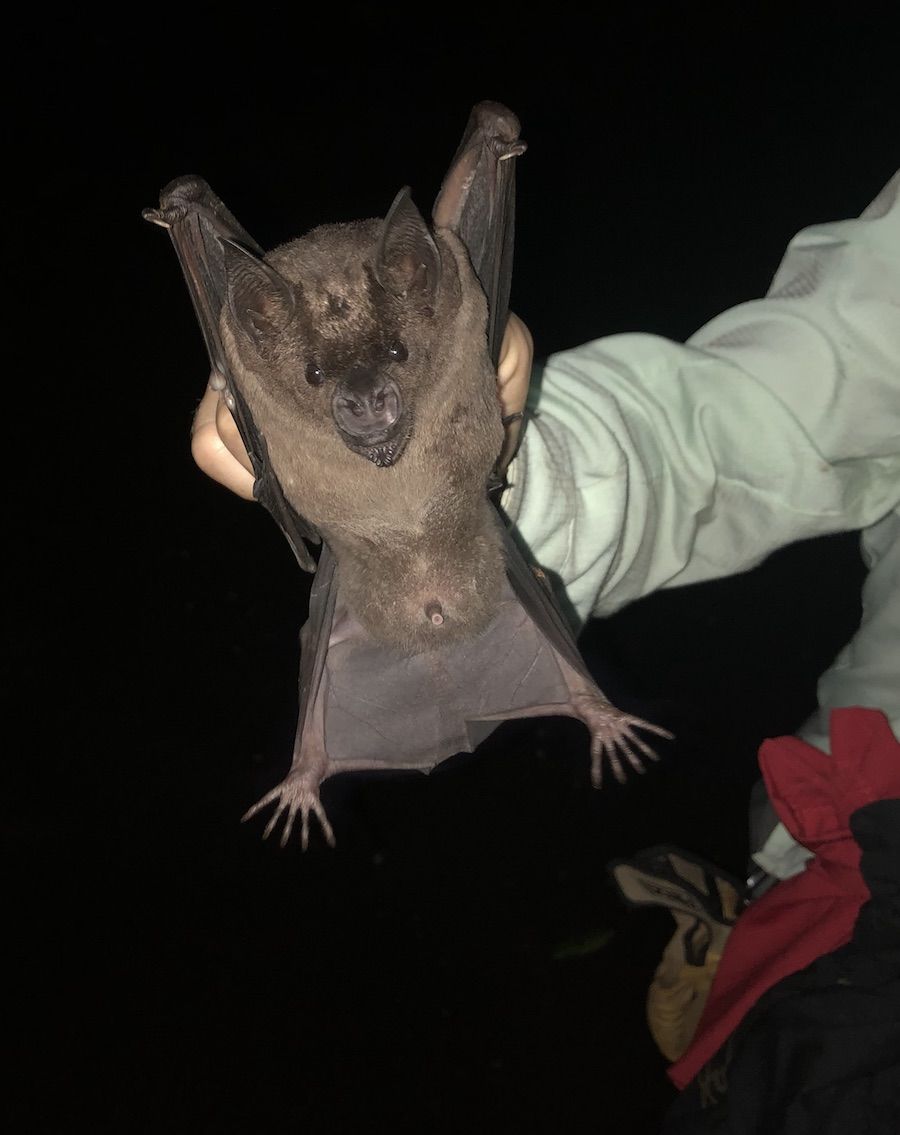
The greater spear-nosed bat, one of the largest bats in the Americas, has a varied diet, from fruits to rodents. (Photo by Caroline Olson)
The greater spear-nosed bat, one of the largest bats in the Americas, has a varied diet, from fruits to rodents. (Photo by Caroline Olson)
“We have a lot to learn from bats,” says Vicente, noting that many mysteries remain about their myriad behaviors and physiologies.
Bats are the only mammals that fly, which may help explain why their immune systems can tolerate an array of viruses that are lethal to other mammals. One theory is that the high metabolic rate required for flight mimics a fever state in bats. Their immune systems evolved mechanisms that allow them to keep pathogens in check while also putting the brakes on anti-inflammatory molecules when their bodies heat up during flight. Bats’ ability to resolve a state of near-constant inflammation may be one reason they live longer lives compared to mammals of similar body size.
For the Costa Rica project, the Gillespie Lab is collaborating with the Leibniz Institute for Zoo and Wildlife Research in Berlin, Germany, to help measure how the immune system of the bats changes in response to environmental stressors. If the bats’ immune systems are suppressed, that could give the pathogens they carry an edge, making the spread of a disease more likely.
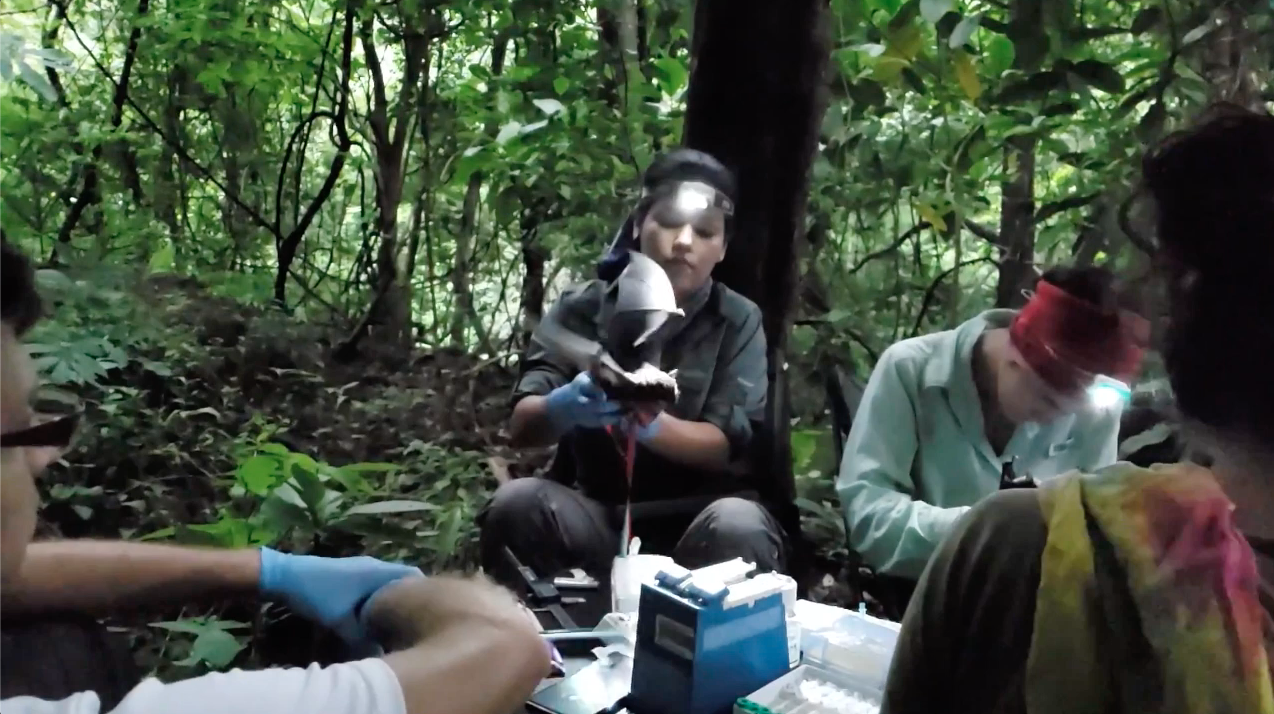
Vicente expands her work by mentoring others. One of her upcoming projects was developed by three Emory students: Christie Jones, Olivia Milloway and Kacy Nowak. Plans had called for them to go into the field this summer to study how cattle ranching in Costa Rica may impact what animals vampire bats choose to feed on, and how that relates to the risk of the spread of rabies virus.
The pandemic caused by the novel coronavirus, however, means the rabies study is on hold.
"When the COVID-19 outbreak started in December and January, many people in the United States thought, 'It's not our problem, it's not in our country,'" Nowak says. "Obviously, now it's a huge problem. It shows why we should do research into the control and prevention of zoonotic diseases, even ones that are not prevalent here."
Nowak, a masters of public health student at Rollins, plans a career in global health and infectious diseases.

Kacy Nowak de-stresses by trailrunning in Medford, Oregon, where she is quarantining at her family home.
Kacy Nowak de-stresses by trailrunning in Medford, Oregon, where she is quarantining at her family home.
She loves lab work and helped with DNA analysis of the Costa Rica bat samples. "Infectious disease research is often focused on the microbiology, the pathogen itself," Nowak says. "But you also need to step back and look at all the factors that influence an outbreak."
The rabies project the students designed would do just that.
“Our project is important,” says Milloway, a sophomore majoring in environmental sciences. “We want to demystify pathogen exchange so instead of having hysteria over bats, we can identify better ways to protect public health in the long run.”
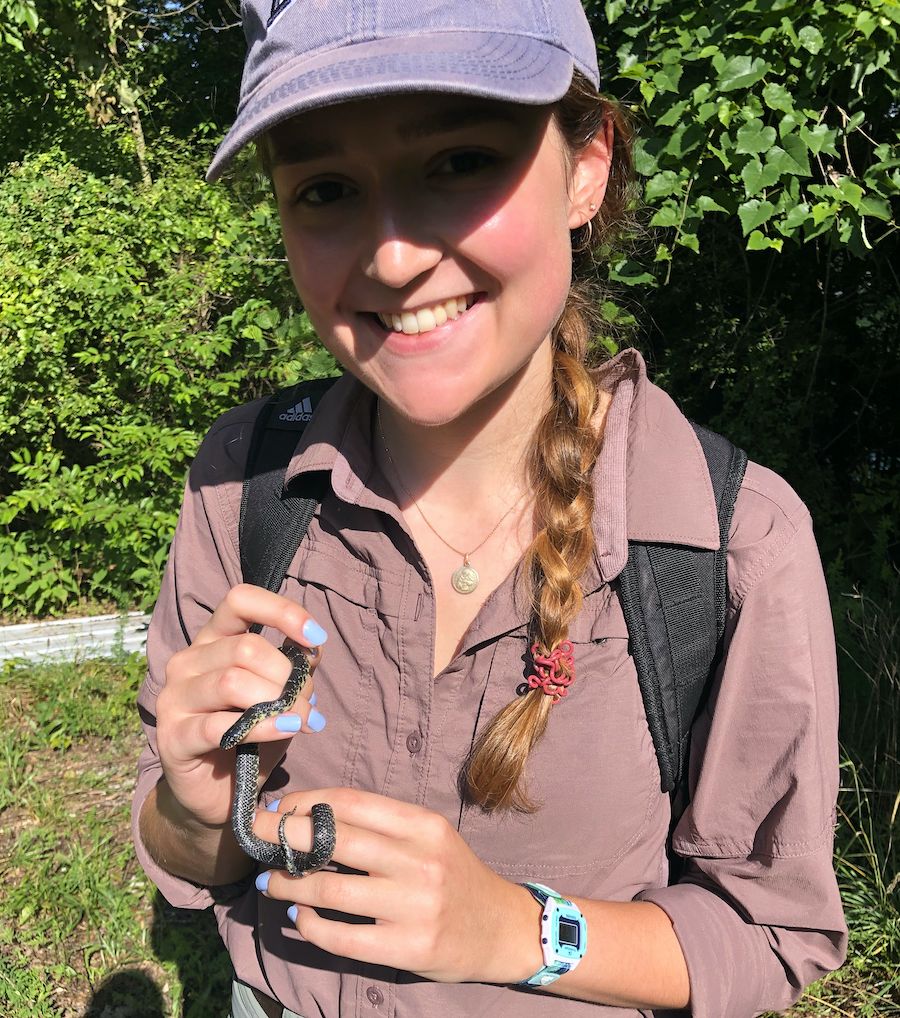
"I'm a super big nerd," admits Milloway, shown near her family home in Tennessee where she is spending quarantine.
"I'm a super big nerd," admits Milloway, shown near her family home in Tennessee where she is spending quarantine.
Milloway is in quarantine at her family home in Oak Ridge, Tennessee. She put up a bat house in the backyard and rediscovered her childhood microscope. Now that she is unable to work on analyzing bat samples, she’s gathering water samples from a nearby wetland to see what micro-organisms she can find.
She has the patient, calm demeanor of someone who spends a lot of time in nature. “We all worked really hard on our research proposal so, of course, it’s disappointing,” Milloway says. “But I have no doubt we will prevail eventually.”
“The whole world is undergoing a public health crisis right now, and attention needs to focus on how to control the COVID-19 pandemic,” Vicente says. “But I hope after this fire is put out there will be increased focus on how to prevent such outbreaks. Healthy forests are good for our own health, not just because they are beautiful places to visit and hike. Keeping wild animals and the ecosystems where they live healthy is vital to protect us from diseases.”
Story and design by Carol Clark
To learn more:
The Gillespie Lab, Emory Department of Environmental Sciences, Rollins School of Public Health
Media inquires: Carol Clark 404-727-0501
carol.clark@emory.edu

